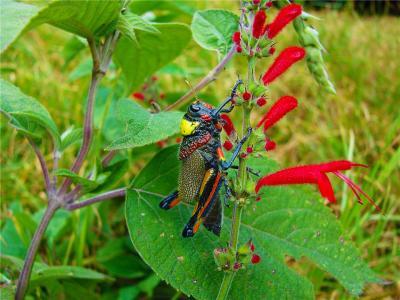There are about 9,700 known species of grasshoppers in the world. Now there is one more, and it has beeen named Grammy-award winning singer and Mexican activist Ana Lila Downs Sanchez.
Locals called the creature the friar grasshopper because its head looks a bit like what a monk with his hood pulled back might look like and so the scientific name of the new grasshopper is Liladownsia fraile. In Spanish, "friale" means friar.
The new species was discovered on the side of a mountain road near Oaxaca, Mexico.
The men were doing fieldwork for another grasshopper study in a pine-oak forest of the Sierra Madre del Sur Mountain Range in Oaxaca, Mexico, when they came across their discovery in 2011.
"It was primarily Paolo's idea to name the grasshopper after the singer" said Derek Woller of University of Central Florida, one of the authors of the paper referring to colleague Paolo Fontana. "He's a big fan of Lila Downs (her stage name). The grasshopper is so beautiful, so vibrant and colorful. When he told us all about her, her work, her colorful clothes, and that she was born in the region where we found the specimens, we thought, yeah, that's great, let's do it."
The grasshopper measures about an inch long on average and resembles a fiery rainbow with blue, red, yellow, orange and black markings.

This is the newly discovered female of the species
Liladownsia fraile. Credit: UCF
The team did some research, returned again in 2013 to see if they could find more grasshoppers and then submitted their work to the journal after confirming three known small populations of the creatures.
The UCF team felt it was important to recognize Mexico in naming the species. Downs is known for her contributions to the music industry through her traditional fashion, which is primarily based on Mexico's indigenous communities, cultures and heritages. Her music has earned her a Grammy Award and two Latin Grammy Awards and she's active with various humanitarian causes especially those related to Latin America's indigenous communities. Young music fans may recognize her because she was a featured artist on Carlos Santana's "Corazon" album with Gloria Estefan, Ziggy Marley, Wayne Shorter and others released earlier this year.
They write: "This taxon is dedicated to (Lila Downs) for a number of reasons, such as the fact that she was born in the vicinity of the type locality and because she incorporates several indigenous tongues from Mexico into her musical style, including Mixteco and Zapoteco (the latter of which is spoken in the type locality). Additionally, Lila Downs has not only promoted the vast cultural diversity of Mexico worldwide via her music, but also through the use of bright colors, a staple of Mexican culture, and considering that this new genus is brightly colored, we would like to recognize her efforts through the dedication of this new genus."

Lila Downs. Credit: Studio 92
Though it has just been discovered, it's already been placed on the International Union for Conservation of Nature's new Red List of threatened species, which doesn't make a lot of sense to the public that wonders why something is threatened just because no one had named it before. Mexican villagers have known about it for years.





Comments